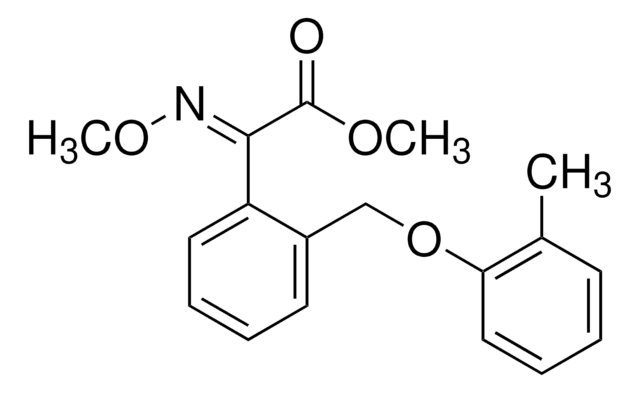45313
Terbufos
PESTANAL®, analytical standard
About This Item
Produits recommandés
Qualité
analytical standard
Niveau de qualité
Gamme de produits
PESTANAL®
Durée de conservation
limited shelf life, expiry date on the label
Technique(s)
HPLC: suitable
gas chromatography (GC): suitable
Application(s)
agriculture
environmental
Format
neat
Température de stockage
2-8°C
Chaîne SMILES
CCOP(=S)(OCC)SCSC(C)(C)C
InChI
1S/C9H21O2PS3/c1-6-10-12(13,11-7-2)15-8-14-9(3,4)5/h6-8H2,1-5H3
Clé InChI
XLNZEKHULJKQBA-UHFFFAOYSA-N
Vous recherchez des produits similaires ? Visite Guide de comparaison des produits
Catégories apparentées
Description générale
Terbufos is not approved for its use in the European Union.
Maximum residue levels (MRLs) have been set according to Reg (EC) No 149/2008 for Terbufos for various products of plant and animal origin 0.01 mg/kg.
Terbufos in its activated form irreversibly inhibits acetylcholinesterase (AChE), leading to the accumulation of acetylcholine, resulting in overstimulation of muscarinic and nicotinic receptors.
Application
- Protect and detect two thermolabile metabolites of terbufos, and simultaneously analyze terbufos and its metabolites in pepper and pepper leaf samples using GC-FPD
- Investigate photocatalytic degradation of terbufos in aqueous suspensions using titanium dioxide (TiO2) as a photocatalyst
- Study the effects of different doses of terbufos on the decomposition process and the scavenger flies assemblages composition in Wistar rat carcasses
- Measure adsorption of two commonly used organophosphorus pesticides, Phorate and Terbufos onto four tropical soils
- Examine the acute effects of terbufos and its major oxidation products, alone and in combination with each other or with atrazine, on Ceriodaphnia cf dubia
- Investigate the molecular mechanisms of genotoxicity in HepG2 cells and zebrafish embryos following exposure to terbufos, fenthion, or combinations of these pesticides
Informations légales
Mention d'avertissement
Danger
Mentions de danger
Conseils de prudence
Classification des risques
Acute Tox. 1 Dermal - Acute Tox. 2 Oral - Aquatic Acute 1 - Aquatic Chronic 1
Code de la classe de stockage
6.1A - Combustible, acute toxic Cat. 1 and 2 / very toxic hazardous materials
Classe de danger pour l'eau (WGK)
WGK 3
Point d'éclair (°F)
Not applicable
Point d'éclair (°C)
Not applicable
Équipement de protection individuelle
Eyeshields, Faceshields, Gloves, type ABEK (EN14387) respirator filter
Choose from one of the most recent versions:
Déjà en possession de ce produit ?
Retrouvez la documentation relative aux produits que vous avez récemment achetés dans la Bibliothèque de documents.
Les clients ont également consulté
Notre équipe de scientifiques dispose d'une expérience dans tous les secteurs de la recherche, notamment en sciences de la vie, science des matériaux, synthèse chimique, chromatographie, analyse et dans de nombreux autres domaines..
Contacter notre Service technique















